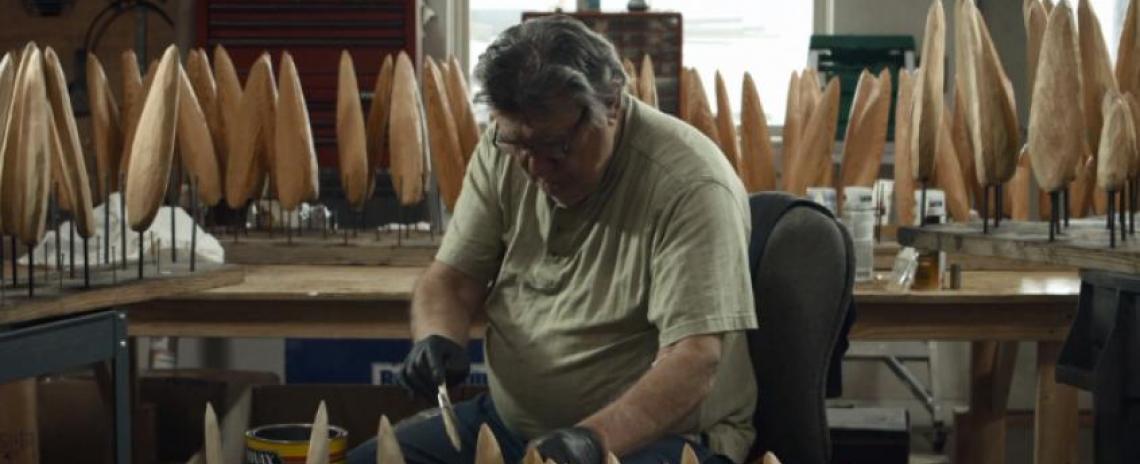Throughout the 27th Annual Whitaker St. Louis International Film Festival (SLIFF), the writers at the Lens will be spotlighting their favorite narrative and documentary films on this year's festival schedule. Each day, our critics will discuss can't-miss festival highlights, foreign gems that have already made an international splash, and smaller cinematic teasures that might have overwise been overlooked – just in time for you to snap up tickets.
Even if the name of sculptor James Surls is unfamiliar – indeed, even if one knows virtually nothing about the landscape of contemporary American art – the man’s pieces possess a primal resonance that often strikes a rumbling chord in anyone who lays eyes on them. Massive works in wood and metal, they typically incorporate hard, masculine shapes such as blades, prisms, and blocks, while also reflecting more organic macro-forms: tendrils, branches, and floral whorls. Surl’s work – which includes not only sculptures, but also prints, rubbings, and hallucinatory line drawings – has the uncommon luster of art that has forced its way into the world out of sheer necessity, rather than because the artist has “something to say.” While Surl’s sculptures are hardly denuded of cultural or political voice, they nonetheless seem to thrum with the same unmistakable atavistic energy that radiates from Paleolithic cave paintings.
The impressively prolific Surls resists categorization: Loosely identifiable as a modernist, he belongs to no definitive artistic tradition, movement, or “school”. Brothers Austin and Maitland Lottimer have crafted a fittingly distinctive vehicle for this under-appreciated American original with their absorbing new documentary feature, The House, the Hand and the Hatchet. A different sort of film might have taken a more prosaic biographical approach, endeavoring to correct Surls’ relative pop obscurity by unearthing the nitty-gritty details of his life for wider examination. The Lottimers, however, employ a method more akin to true portraiture, presenting a snapshot of the seventy-something artist as he is now, while also privileging the imposing tangibility of the sculptures themselves.
The traditional biodoc elements aren’t wholly neglected in House. Surls’ personal story – particularly his early life with his wife and young daughters in the woodlands of East Texas – deeply informs his work, and the Lottimers periodically reference that past through archival VHS footage and vintage news clips. In the main, however, their documentary is focused on the present day. Indeed, House is best described as a fly-on-the-wall film, following Surls in 2015 as he lives the life of a veteran artist with no intention of slowing down: laboring diligently on new pieces in his Colorado studio; lecturing to enthralled art students; overseeing new installations and exhibitions of his work; and sitting for a frank (if friendly) retrospective interview.
Shadowing the sculptor in this fashion provides a vérité immediacy, but House is as interested in Surls’ worldview as in the procedural minutiae of his artistic process. To that end, the film provides the man with the space to expound freely on his life and work, revealing a personality that is thoughtful and poetic, and yet also admirably no-bullshit. Surls cuts a contradictory but clearly-defined figure, and it’s easy to see why the Lottimers find him so compelling. He boasts the education, erudition, and staggering resume of an artist’s artist – he has a MFA from Michigan’s prestigious Cranbrook Academy of Art – but also the down-to-earth, curmudgeonly streak of a Western straight-shooter. Pointedly, Surls is widely dismissive of much of the contemporary art world. He is, in almost every respect, as independent and incomparable as they come.
That said, other people with a significant role in Surls’ day-to-day routine appear prominently in the film, including his wife, daughter and assistant. However, these individuals are not afforded much opportunity to discuss themselves, beyond some cursory talking-head footage. Instead, Surls talks about them, illuminating their essential role in his artistic process and their cherished presence in his life. This is in keeping with House’s focus on the artist as individual, an ambition that is further reflected in the film’s fascination with the physical aspects of his distinctive work: the planes, curves, textures, colors, and shadows. Above all, the Lottimers convey the daunting solidity and weight of Surls’ sculptures, traits that have intrinsic meaning in an era when American culture seems driven principally by digital ephemera.
The sheer, unwieldy bulk of Surls’ more massive sculptures even becomes a plot point late in the film, when the artist travels to Singapore to oversee the installation of a piece at that island nation’s renowned Botanic Gardens. As absurd, unforeseen bureaucratic and engineering complications arise surrounding the installation, Surls’ mounting, exhausted annoyance becomes palpable. This frustrating episode highlights the weary cynicism that occasionally peeks through the unflagging creative diligence that has produced a body of work that now encompasses some 350 pieces. That subtle undercurrent of fatigue is essential to the wistful tone that the Lottimers strike in their film, which skillfully conveys the spirit of a septuagenarian artist who remains bracingly vital yet can’t resist ruminating on his legacy. It’s this low-key litheness that distinguishes the engaging The House, the Hand and the Hatchet overall, marking it as an ideal introduction to a vigorous, essential American figure.
The House, the Hand and the Hatchet screens Thursday, Nov. 8 at 7:30 p.m. at .ZACK.


